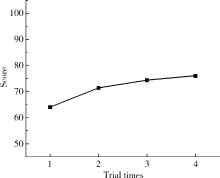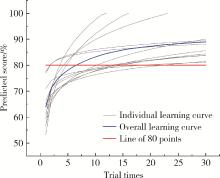Journal of Peking University (Health Sciences) ›› 2023, Vol. 55 ›› Issue (1): 108-113. doi: 10.19723/j.issn.1671-167X.2023.01.016
Previous Articles Next Articles
Prediction, analysis and application of learning curve of tooth preparation for all ceramic crowns of maxillary central incisors
Si-yu WU,Ya-ning LI,Xiao ZHANG,Long-wei LV,Yun-song LIU,Hong-qiang YE*( ),Yong-sheng ZHOU*(
),Yong-sheng ZHOU*( )
)
- Department of Prosthodontics, Peking University School and Hospital of Stomatology & National Center of Stomatology & National Clinical Research Center for Oral Diseases & National Engineering Research Center of Oral Biomaterials and Digital Medical Devices & Beijing Key Laboratory of Digital Stomatology, Beijing 100081, China
CLC Number:
- R783.2
| 1 |
周永胜, 江泳, 徐军, 等. 仿真头颅模型在口腔修复学临床前期教学中的应用[J]. 中华医学教育杂志, 2006, 26 (3): 74- 76.
doi: 10.3760/cma.j.issn.1673-677X.2006.03.031 |
| 2 | 刘星纲, 刘利霞, 魏永杰. 浅析研究生修复实习中牙体预备的学习曲线[J]. 北京口腔医学, 2018, 26 (4): 236- 237. |
| 3 | Wright TP . Factors affecting the cost of airplanes[J]. J Astronaut Sci, 1936, 3 (4): 122- 128. |
| 4 |
Sun TM , Lan TH , Pan CY , et al. Dental implant navigation system guide the surgery future[J]. Kaohsiung J Med Sci, 2018, 34 (1): 56- 64.
doi: 10.1016/j.kjms.2017.08.011 |
| 5 |
Lim JH , Park JM , Kim M , et al. Comparison of digital intraoral scanner reproducibility and image trueness considering repetitive experience[J]. J Prosthet Dent, 2018, 119 (2): 225- 232.
doi: 10.1016/j.prosdent.2017.05.002 |
| 6 |
Ben-Gal G , Katorza L , Weiss EI , et al. Testing motor learning curves among dental students[J]. J Dent Educ, 2017, 81 (10): 1171- 1178.
doi: 10.21815/JDE.017.076 |
| 7 |
Son K , Lee WS , Lee KB . Prediction of the learning curves of 2 dental CAD software programs[J]. J Prosthet Dent, 2019, 121 (1): 95- 100.
doi: 10.1016/j.prosdent.2018.01.004 |
| 8 |
Son K , Lee KB . Prediction of learning curves of 2 dental CAD software programs, part 2: Differences in learning effects by type of dental personnel[J]. J Prosthet Dent, 2020, 123 (5): 747- 752.
doi: 10.1016/j.prosdent.2019.05.026 |
| 9 |
Goodacre CJ , Campagni WV , Aquilino SA . Tooth preparations for complete crowns: An art form based on scientific principles[J]. J Prosthet Dent, 2001, 85 (4): 363- 376.
doi: 10.1067/mpr.2001.114685 |
| 10 | 赵铱民. 口腔修复学[M]. 7版 北京: 人民卫生出版社, 2012: 96- 97. |
| 11 | 周永胜. 口腔修复学[M]. 3版 北京: 北京大学医学出版社, 2020: 87- 89. |
| 12 |
Al Amri MD , Sherfudhin HR , Habib SR . Effects of evaluator's fatigue and level of expertise on the global and analytical evaluation of preclinical tooth preparation[J]. J Prosthodont, 2018, 27 (7): 636- 643.
doi: 10.1111/jopr.12558 |
| 13 | 李坚, 李泽. 学习曲线与进步函数: 考虑技术进步因素的优化方法[J]. 水利电力机械, 1997, (1): 3- 9.3-9, 11 |
| [1] | Ran ZHAO,Yan-qing LIU,Hua TIAN. Cumulative sum control chart analysis of soft tissue balance in total knee replacement assisted by electronic pressure sensor [J]. Journal of Peking University (Health Sciences), 2023, 55(4): 658-664. |
| [2] | SUN Yu-chun,GUO Yu-qing,CHEN Hu,DENG Ke-hui,LI Wei-wei. Independent innovation research, development and transformation of precise bionic repair technology for oral prosthesis [J]. Journal of Peking University (Health Sciences), 2022, 54(1): 7-12. |
| [3] | XU Xiao-xiang,CAO Ye,ZHAO Yi-jiao,JIA Lu,XIE Qiu-fei. In vitro evaluation of the application of digital individual tooth tray in the impression making of mandibular full-arch crown abutments [J]. Journal of Peking University (Health Sciences), 2021, 53(1): 54-61. |
| [4] | Yang LIU,Jin-ru HU,Yi-jiao ZHAO,Yong WANG,Yu-chun SUN,Shao-xia PAN,Hai-lan FENG. A novel tray for recording maxillomandibular relationship of edentulous patients based on dimensional surveying of complete dentures [J]. Journal of Peking University (Health Sciences), 2020, 52(2): 368-372. |
| [5] | Xin-xin LI,Yu-shu LIU,Yu-chun SUN,Hu CHEN,Hong-qiang YE,Yong-sheng ZHOU. Evaluation of one-piece polyetheretherketone removable partial denture fabricated by computer-aided design and computer-aided manufacturing [J]. Journal of Peking University(Health Sciences), 2019, 51(2): 335-339. |
| [6] | Yan-jun GE,Xiao-qiang LIU. Effects of loupes and microscope on laminate veneer preparation [J]. Journal of Peking University(Health Sciences), 2019, 51(1): 100-104. |
| [7] | LIU Yu-shu1, 2*, LI Zheng1*, ZHAO Yi-jiao, YE Hong-qiang, ZHOU Yan-qiu,HU Wen-jie, LIU Yun-song,XUN Chun-lei, ZHOU Yong-sheng. Application of digital design of orthodontic-prosthodontic multidisciplinary treatment plan in esthetic rehabilitation of anterior teeth [J]. Journal of Peking University(Health Sciences), 2018, 50(1): 78-84. |
| [8] | LI Hao, LIU Yu-hua, LUO Zhi-qiang. Effects of bioactive glass on reducing the hypersensitivity after full crown preparation [J]. Journal of Peking University(Health Sciences), 2017, 49(4): 709-713. |
| [9] | ZHOU Tuan-feng,WANG Xin-zhi, LIU Jing-yin, SUN Qing, WANG Xin-kai. Preliminary clinical evaluation of the esthetic effect of deep discolored anterior teeth restored with zirconia veneers [J]. Journal of Peking University(Health Sciences), 2016, 48(6): 1055-1059. |
| [10] | QIAO Di, DONG Yan-mei, GAO Xue-jun. In vitro study of biological characteristics of new retrograde filling materials iRoot [J]. Journal of Peking University(Health Sciences), 2016, 48(2): 324-329. |
| [11] | WEI Yan, CHEN Gui, HAN Bing, HU Xiao-yang, ZHANG Han-ping, DENG Xu-liang. Three-dimensional imaging for quantitative evaluation of facial profile of edentulous patients before and after complete dentures restoration [J]. Journal of Peking University(Health Sciences), 2014, 46(1): 100-103. |
|
||



